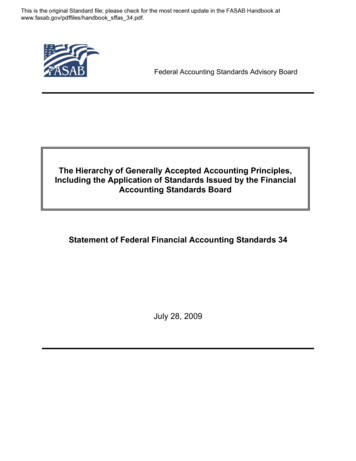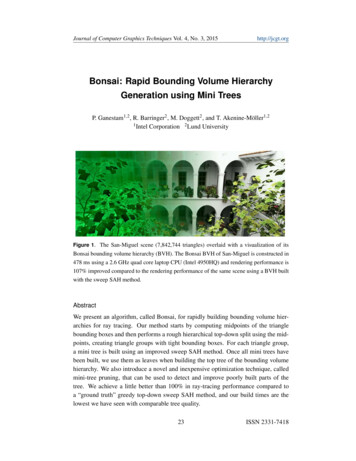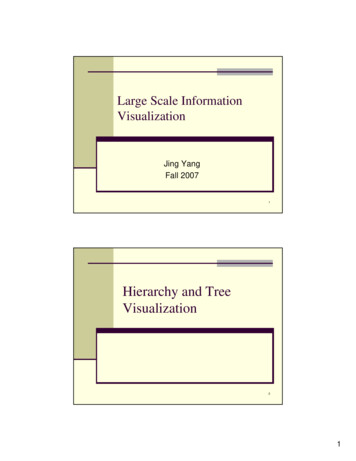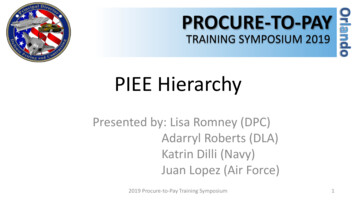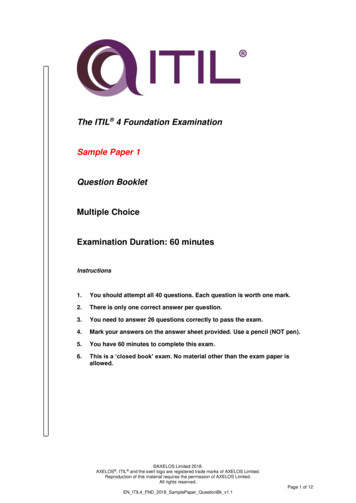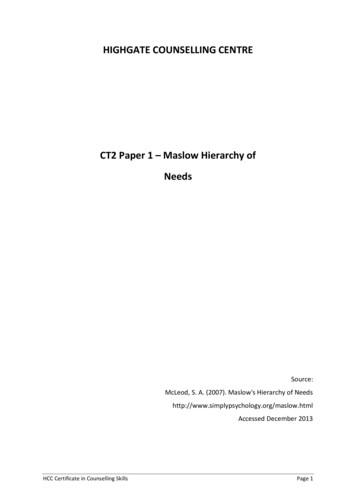
Transcription
HIGHGATE COUNSELLING CENTRECT2 Paper 1 – Maslow Hierarchy ofNeedsSource:McLeod, S. A. (2007). Maslow's Hierarchy of cessed December 2013HCC Certificate in Counselling SkillsPage 1
Maslow's Hierarchy of Needsby Saul McLeod - published 2007, updated 2013Maslow wanted to understand what motivates people. He believed that individuals possess aset of motivation systems unrelated to rewards or unconscious desires.Maslow (1943) stated that people are motivated to achieve certain needs. When one need isfulfilled a person seeks to fulifil the next one, and so on.The earliest and most widespread version of Maslow's (1943, 1954) hierarchy of needsincludes five motivational needs, often depicted as hierachical levels within a pyramid.This five stage model can be divided into basic (or deficiency) needs (e.g. physiological,safety, love, and esteem) and growth needs (self-actualization).The deficiency, or basic needs are said to motivate people when they are unmet. Also, theneed to fulfil such needs will become stronger the longer the duration they are denied. Forexample, the longer a person goes without food the more hungry they will become.One must satisfy lower level basic needs before progressing on to meet higher level growthneeds. Once these needs have been reasonably satisfied, one may be able to reach thehighest level called self-actualization.Every person is capable and has the desire to move up the hierarchy toward a level of selfactualization. Unfortunately, progress is often disrupted by failure to meet lower level needs.Life experiences including divorce and loss of job may cause an individual to fluctuatebetween levels of he hierarchy.Maslow noted only one in a hundred people become fully self-actualized because our societyrewards motivation primarily based on esteem, love and other social needs.HCC Certificate in Counselling SkillsPage 2
The original hierarchy of needs five-stage model includes:1. Biological and Physiological needs - air, food, drink, shelter, warmth, sex, sleep.2. Safety needs - protection from elements, security, order, law, limits, stability, freedomfrom fear.3. Social Needs - belongingness, affection and love, - from work group, family, friends,romantic relationships.4. Esteem needs - achievement, mastery, independence, status, dominance, prestige, selfrespect, respect from others.5. Self-Actualization needs - realizing personal potential, self-fulfillment, seeking personalgrowth and peak experiences.Maslow posited that human needs are arranged in a hierarchy:'It is quite true that man lives by bread alone — when there is no bread. But what happens toman’s desires when there is plenty of bread and when his belly is chronically filled?At once other (and “higher”) needs emerge and these, rather than physiological hungers,dominate the organism. And when these in turn are satisfied, again new (and still “higher”)HCC Certificate in Counselling SkillsPage 3
needs emerge and so on. This is what we mean by saying that the basic human needs areorganized into a hierarchy of relative prepotency'. (Maslow, 1943, p. 375)The expanded hierarchy of needs:It is important to note that Maslow's (1943, 1954) five stage model has been expanded toinclude cognitive and aesthetic needs (Maslow, 1970a) and later transcendence needs(Maslow, 1970b).Changes to the original five-stage model are highlighted and include a seven-stage model anda eight-stage model, both developed during the 1960's and 1970s.1. Biological and Physiological needs - air, food, drink, shelter, warmth, sex, sleep, etc.2. Safety needs - protection from elements, security, order, law, limits, stability, etc.3. Social Needs - Belongingness and Love, - work group, family, affection, relationships, etc.4. Esteem needs - self-esteem, achievement, mastery, independence, status, dominance,prestige, managerial responsibility, etc.5. Cognitive needs - knowledge, meaning, etc.6. Aesthetic needs - appreciation and search for beauty, balance, form, etc.7. Self-Actualization needs - realizing personal potential, self-fulfillment, seeking personalgrowth and peak experiences.8. Transcendence needs - helping others to achieve self actualization.Self ActualizationInstead of focusing on psychopathology and what goes wrong with people, Maslow (1943)formulated a more positive account of human behaviour which focused on what goes right.He was interested in human potential, and how we fulfill that potential.Psychologist Abraham Maslow (1943, 1954) stated that human motivation is based on peopleseeking fulfillment and change through personal growth. Self-actualized people as those whowere fulfilled and doing all they were capable of.The growth of self-actualization (Maslow, 1962) refers to the need for personal growth that ispresent throughout a person’s life. For Maslow, a person is always “becoming” and neverremains static in these terms. In self-actualization a person comes to find a meaning to lifethat is important to them.As each person is unique the motivation for self-actualization leads people in differentdirections (Kenrick et al., 2010). For some people self-actualization can be achieved throughcreating works of art or literature, for others through sport, in the classroom, or within acorporate setting.HCC Certificate in Counselling SkillsPage 4
It is important to note that self-actualization is a continual process of becoming rather than aperfect state one reaches of a 'happy ever after' (Hoffman, 1988).Maslow offers the following description of self- actualization:'It refers to the person’s desire for self-fulfillment, namely, to the tendency for him to becomeactualized in what he is potentially.The specific form that these needs will take will of course vary greatly from person to person.In one individual it may take the form of the desire to be an ideal mother, in another it may beexpressed athletically, and in still another it may be expressed in painting pictures or ininventions'. (Maslow, 1943, pp. 382– 383).Maslow (1968): Some of the characteristics of selfactualized peopleAlthough we are all, theoretically, capable of self-actualizing, most of us will not do so, oronly to a limited degree. Maslow (1970) estimated that only two percent of people will reachthe state of self actualization. He was particularly interested in the characteristics of peoplewhom he considered to have achieved their potential as persons.By studying 18 people he considered to be self-actualized (including Abraham Lincoln andAlbert Einstein) Maslow (1970) identified 15 characteristics of a self-actualized person.Characteristics of self-actualizers:1. They perceive reality efficiently and can tolerate uncertainty;2. Accept themselves and others for what they are;3. Spontaneous in thought and action;4. Problem-centered (not self-centered);5. Unusual sense of humor;6. Able to look at life objectively;7. Highly creative;8. Resistant to enculturation, but not purposely unconventional;9. Concerned for the welfare of humanity;10. Capable of deep appreciation of basic life-experience;11. Establish deep satisfying interpersonal relationships with a few people;12. Peak experiences;HCC Certificate in Counselling SkillsPage 5
13. Need for privacy;14. Democratic attitudes;15. Strong moral/ethical standards.Behavior leading to self-actualization:(a) Experiencing life like a child, with full absorption and concentration;(b) Trying new things instead of sticking to safe paths;(c) Listening to your own feelings in evaluating experiences instead of the voice of tradition,authority or the majority;(d) Avoiding pretense ('game playing') and being honest;(e) Being prepared to be unpopular if your views do not coincide with those of the majority;(f) Taking responsibility and working hard;(g) Trying to identify your defenses and having the courage to give them up.The characteristics of self-actualizers and the behaviors leading to self-actualization areshown in the list above. Although people achieve self-actualization in their own unique way,they tend to share certain characteristics. However, self-actualization is a matter of degree,'There are no perfect human beings' (Maslow, 1970a, p. 176).It is not necessary to display all 15 characteristics to become self-actualized, and not onlyself-actualized people will display them. Maslow did not equate self-actualization withperfection. Self-actualization merely involves achieving ones potential. Thus someone canbe silly, wasteful, vain and impolite, and still self-actualize. Less than two percent of thepopulation achieve self-actualization.Critical EvaluationThe most significant limitation of Maslow's theory concerns his methodology. Maslowformulated the characteristics of self-actualized individuals from undertaking a qualitativemethod called biographical analysis.He looked at the biographies and writings of 18 people he identified as being selfactualized. From these sources he developed a list of qualities that seemed characteristic ofthis specific group of people, as opposed to humanity in general.From a scientific perspective there are numerous problems with this particularapproach. First, it could be argued that biographical analysis as a method is extremelysubjective as it is based entirely on the opinion of the researcher. Personal opinion is alwaysprone to bias, which reduces the validity of any data obtained. Therefore Maslow'soperational definition of self-actualization must not be blindly accepted as scientific fact.HCC Certificate in Counselling SkillsPage 6
Furthermore, Maslow's biographical analysis focused on a biased sample of self-actualizedindividuals, promoninately limited to highly educated white males (such as ThomasJefferson, Abraham Lincoln, Albert Einstein, Willliam James, Aldous Huxley, Gandhi,Beethoven).Although Maslow (1970) did study self-actualized females, such as Eleanor Roosevelt andMother Teresa, they comprised a small proportion of his sample. This makes it difficult togeneralise his theory to females and indviduals from lower social classes or differentethnicity. Thus questioning the population validity of Maslow's findings.Furthermore, it is extremely difficult to empirically test Maslow's concept of selfactualization in a way that causal relationships can be established.Another criticism concerns Maslow's assumption that the lower needs must be satisfiedbefore a person can achieve their potential and self-actualize. This is not always the case, andtherefore Maslow's hierarchy of needs in some aspects has been falsified.Through examining cultures in which large numbers of people live in poverty (such as India)it is clear that people are still capable of higher order needs such as love andbelongingness. However, this should not occur, as according to Maslow, people who havedifficulty achieving very basic physiological needs (such as food, shelter etc.) are not capableof meeting higher growth needs.Also, many creative people, such as authors and artists (e.g. Rembrandt and Van Gough)lived in poverty throughout their lifetime, yet it could be argued that they achieved selfactualization.ReferencesHoffman, E. (1988). The right to be human: A biography of Abraham Maslow. Jeremy P.Tarcher, Inc.Kenrick, D. T., Neuberg, S. L., Griskevicius, V., Becker, D. V., & Schaller, M. (2010). GoalDriven Cognition and Functional Behavior The Fundamental-Motives Framework. CurrentDirections in Psychological Science, 19(1), 63-67.Maslow, A. H. (1943). A Theory of Human Motivation. Psychological Review, 50(4), 37096.Maslow, A. H. (1954). Motivation and Personality. New York: Harper and Row.Maslow, A. H. (1962). Towards a Psychology of Being. Princeton: D. Van NostrandCompany.Maslow, A. H. (1968). Toward a Psychology of Being. New York: D. Van NostrandCompany.Maslow, A. H. (1970a). Motivation and Personality. New York: Harper & Row.HCC Certificate in Counselling SkillsPage 7
Maslow, A. H. (1970b). Religions, values, and peak experiences. New York: Penguin.(Original work published 1964)HCC Certificate in Counselling SkillsPage 8
'It refers to the person’s desire for self-fulfillment, namely, to the tendency for him to become actualized in what he is potentially. The specific form that these needs will take will of course vary greatly from person to person. In one individual it may take the form of the de

